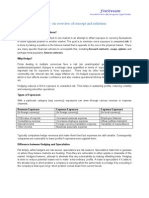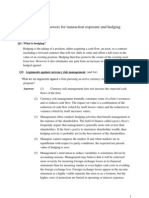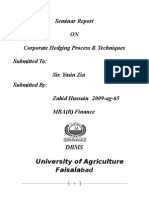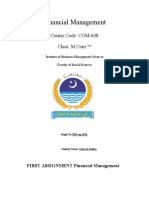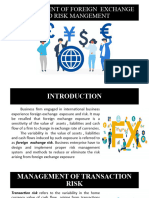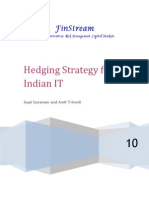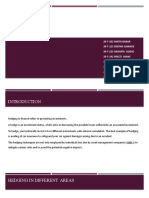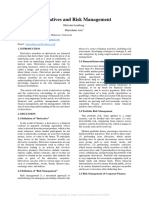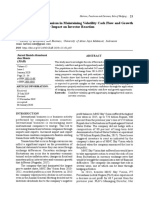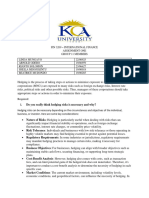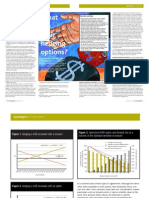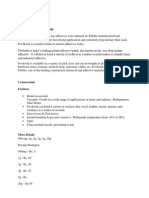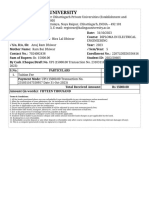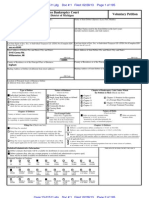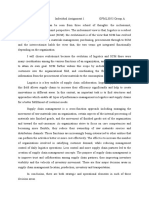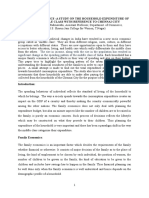Question no.
a) The basic goal of risk management is to have enough cash flow available to them for making value enhancing investments and enable companies to become better at aligning the demand for funds with the internal supply of funds. Cash flow is an important factor in the investment process which would be disrupted by movements in external factors such as exchange rates, commodity prices and interest rates etc. Internally generated cash is a competitive tool which reduces companys cost of capital and facilitates investment. So they prefer to make investments through retained earnings rather than external funding. They should have stabilized operating income and retained earnings so that the enough cash flow would be generated which will help in investments. There is no issue regarding stock price volatility because such volatility can be better managed by individual investors through their portfolio strategies. By contrast, excessive volatility can threaten a companys ability to meet its strategic objectives and, a result, it is worth controlling through risk management. Question B).Hedging is a risk management strategy that is applied by companies in order to protect capital against effects of inflation. Companies go for hedging with the intention of limiting or minimizing the probability of loss from fluctuations in the prices of currencies, commodities or securities. Companies who do business overseas faces exposure to currency risk. In such a case, the companys cash flow is susceptible to risk, that upon conversion it has less cash to continue its operations. To offset potential risks to its cash flow, the company may hedge to protect itself against adverse currency fluctuations. For example, a company may purchase forward contract on a currency, allowing it to purchase the currency at a specified price. There is no simple answer whether the firm should go for hedge or not. Various benefits and costs of hedging are: Benefits:
1. Hedging reduces financial distress If an organization is in financial distress, the shareholders will be reluctant to provide additional equity for funding value-adding projects because part of the added value will go to the creditors. This causes an underinvestment problem. By reducing the volatility of expected future cash flows, hedging reduces or eliminates financial distress and increases value. This reduces or eliminates the risk of suboptimal investment decision-making. 2. Hedging increases borrowing capacity By reducing the volatility of enterprise value, more creditors are willing to provide debt to the organization. Although, additional debt financing creates value only if it is the only way to fund projects with positive net present value (NPV), hedging increases the borrowing capacity of an organization due to efficient risk management. 3. Hedging dilutes asymmetric information If an organization experiences volatility in earnings, shareholders cannot know if this volatility is due to financial risks that could be hedged or caused by ineffective managerial decision-making. Given that shareholders and management do not share the same amount of information and that organizations have superior information about financial risks that could be hedged, hedging dilutes asymmetric information. If shareholders see steadily growing profits and dividend management policies they have more faith in the organization, although they have not the same knowledge of financial risks.
�4. Hedging anticipates risk aversion Increased volatility in corporate value affects the organization's ability to conduct normal business in several areas including trade credit, customer satisfaction and employee retaining. By reducing volatility using hedging, managers anticipate their risk aversion. Moreover, hedging makes not only shareholders, but also stakeholders feel more comfortable, including employees, customers, suppliers and the broader community that the organization does business with. Costs of hedging: Although there are arguments in favour of hedging, there are both theoretical and practical reasons that organizations do not hedge. First of all, in regards to financial distress, although the shareholders are reluctant to provide additional equity for funding value-adding projects, being in financial distress increases the volatility of the assets. This means that shareholders benefit from the upside variation while lenders undertake the downside risk. These circumstances might deter shareholders from hedging. Secondly, shareholders are better able than organizations to diversify portfolio risk. An investor's well-diversified portfolio may be unaffected by the financial risks faced by an organization. If investors are better equipped with the skills and expertise to hedge on their own, they should do so. Moreover, if organizations are acting in the best interest of their well-diversified shareholders, hedging is, most of the times, unnecessary. Thirdly, there is an issue with diversifiable risks in the financial markets. The standard model used to explain the relationship between risk and return, Capital Asset Pricing Model (CAPM), considers the risk free rate (r) plus a risk premium to determine the required rate of return and the beta (b) of each asset to determine the systematic risk, which, however, cannot be removed by diversification. Therefore, hedging changes neither the expected future cash flows nor the required rate of return if the risks being hedged are diversifiable. Question c.) Exchange rate risk and commodity price risk are those risks which should be hedged. The instruments and strategies which are appropriate: 1. Investment choices
2. Financing choices 3. Insurance 4. Derivatives futures, forwards and options. Companies should pay close attention to the hedging strategies of their competitors. The nature of investment opportunities can inform the companys risk management strategy. The investment opportunities depend on the overall structure of the industry and on the financial strength of its competitors.
Question d.) Forward based contracts forwards, swaps and futures the user promises to buy or sell an asset at a Option-based contracts options, caps and floors the holder of an option can choose to buy or sell the
�specified price on a specified date. Forward contracts are linear in nature. When a forward contract is initiated, no money changes hands.
These are traded over the counter and not traded on an exchange. These are not settled until their maturity date.
underlying asset at a specified price on a specified date but is not obliged to do so. Option-contracts are non-linear in nature. Unlike forward based contracts, options require an initial investment when the position is established. The user pays an option premium up front in exchange for the right to walk away later on. Options are available both on exchanges and over the counter. Options are settled when they are exercised, which may occur before the maturity date.





